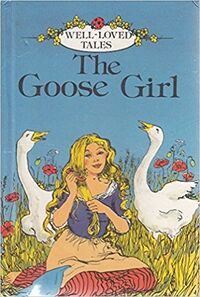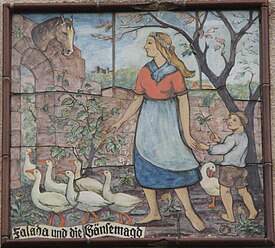
Front cover of an edition of "The Goose Girl" published by the British children's books publisher Ladybird Books in 1982.
"The Goose Girl" (German: "Die Gänsemagd") is a German fairy tale. The Brothers Grimm included it in the second volume of their anthology Kinder- und Hausmärchen (Children's and Household Tales), first published in 1815, and all subsequent editions of the complete anthology.
The story's title character and protagonist is a princess who is abused and cheated out of her proper position by a cruel servant. While they are on the way to another kingdom, so that the princess can marry a prince she has never met, the servant forces the princess to change places with her. When they arrive in the other kingdom, the servant claims the prince as her husband and arranges for the princess to be given a job looking after geese. The goose girl begins to behave strangely. Her odd behavior attracts the attention of the king.
Although it is not one of the best known of the Brothers Grimm's fairy tales in the English-speaking world, there have been numerous adaptations of "The Goose Girl" to other media.
Plot[]
An old queen, who has been widowed for many years, has one daughter. It is arranged for the princess to marry a prince from another kingdom whom she has never met. Before the princess travels off to the other kingdom, the queen gets three drops of her own blood to fall onto a cloth. She gives the cloth to the princess to offer her magical protection on the journey. The princess puts the cloth down the front of her dress. The princess rides to the other kingdom on a horse called Falada that is capable of human speech. She is accompanied by a maid riding on another horse.
The princess asks the maid to fetch her some water from a stream. The maid refuses and tells the princess to get the water herself. As she fetches the water, the cloth that her mother gave her falls out of the princess' dress and is carried away by the stream. The maid knows that the princess has lost the magical protection that she had. She orders the princess to swap clothes with her. The maid then gets on Falada and orders the princess to get on the other horse. She makes the princess take a sacred vow not to tell anybody about what has happened.

Street art depicting a scene from "The Goose Girl" in Vienna, Austria.
When they arrive in the other kingdom, the maid is taken for the princess and marries the prince. The false princess asks for some job to be given to the real princess. She is told to help a young man named Curdken to look after the geese. Fearful that Falada might say something, the false princess arranges to have the horse killed. The real princess, who is now the goose girl, persuades the horse slaughterer to put Falada's head up over a gate under which she passes each day.
When she passes under the gate each day, the goose girl speaks to Falada's head. Each day, Falada's head replies to the goose girl. The dead horse calls the goose girl "Princess fair" and says that her mother would be brokenhearted if she knew what had happened to her. Each day, while the geese look for food in a field, the goose girl stops to comb her hair. Curdken always tries to take some of the beautiful golden hairs from her head. In order to stop this, the goose girl always says a rhyme. A gust of wind then magically comes along. It blows off Curdken's hat and he chases after it.

Early 20th century illustration for "The Goose Girl" by the British artist Jennie Harbour.
Curdken becomes irritated by the goose girl's strange behavior and by the strange things that happen when he is in her company. He tells the king all about them. The following day, the king follows Curdken and the goose girl from a distance and watches them secretly. He sees that everything that Curdken said is true.
In the evening, the king calls the goose girl to him and asks her to explain herself. She says that she cannot because she took a sacred vow never to tell anyone. The king shows the goose girl a little iron stove and tells her that she can confide her troubles to that. He then leaves the room. The goose girl tells the stove that she is really a princess who has been cruelly abused by the maid who took her place. The king, who is standing outside the room, hears everything. He tells his son. The prince is then married to the true princess.
The king asks the false princess for some advice. He asks her what punishment should be given to an impostor who has deceived everyone. The false princess says that the impostor should be put in a barrel full of nails and dragged through the street by two horses until she is dead. The false princess is executed in the cruel manner that she selected for herself.[1]
Adaptations[]
Many works of literature have been inspired by "The Goose Girl". The American author Harold MacGrath adapted the story as the novel The Goose Girl that was first published in 1909. "The Goose Girl" is referenced in the 1974 poem "The Fact of a Doorframe" by the American poet Adrienne Rich. The Canadian poet Jay Macpherson references "The Goose Girl" in the poems "Poor Child" and "What Falada Said" that are both included in the 1981 anthology Poems Twice Told: The Boatsman and Welcoming Disaster. The Irish-Canadian author Emma Donoghue rewrote "The Goose Girl" as the short story "The Tale of the Handkerchief" that is included in the 1997 anthology Kissing the Witch. The American author Nancy Farmer adapted the tale as the short story "Falada: the Goose Girl's Horse" that is included in the 2000 anthology A Wolf at the Door. The 2001 novel Goose Chase by the American author Patrice Kindl is a comic retelling of the story. The American author Shannon Hale rewrote the tale as the 2003 fantasy novel The Goose Girl that won the Josette Frank Award for youth fiction. The American author Intisar Khanani rewrote "The Goose Girl" as the 2012 novel Thorn. The 2015 novel Dearest by the American author Alethea Kontis combines elements from "The Goose Girl" and Hans Christian Andersen's "The Wild Swans". The 2017 novel The Noble Servant by the American author Melanie Dickerson is a retelling of "The Goose Girl" that also shows influences from Mark Twain's The Prince and the Pauper. The Irish author Deidre Sullivan rewrote "The Goose Girl" as the short story "The Little Gift" that is included in the 2017 anthology Tangleweed and Brine.

Advertisement for the 1915 American silent film The Goose Girl that appeared in Variety magazine on January 23, 1915.
Films based on "The Goose Girl" were produced in Germany in 1910, 1927, 1957, 1971, 1988, 1990 and 2009, in Sweden in 1977 and in the United States in 1912, 1915 and 1985. Many film versions of the story end with the horse Falada being magically brought back to life.
"The Goose Girl" is read by actress Dilys Hamlett in the thirty-eighth episode of the first season of the long-running British children's TV series Jackanory. The episode was first broadcast on BBC 1 on February 2, 1966. The story was adapted as an episode of the 1976 Japanese anime series Manga Sekai Mukashi Banashi (Japanese: 天使がとおる; also known in English as Manga Fairy Tales of the World and Wonderful, Wonderful Tales from Around the World) and as the thirteenth episode of the second season of the German animated TV series Simsala Grimm that was first shown on the channel Kindercanal in Germany on July 21, 2000.
The opera Königskinder ("The King's Children"), with music by the German composer Engelbert Humperdinck and libretto by the Austrian-German writer Elsa Bernstein, is partially inspired by "The Goose Girl". It was first performed at the Metropolitan Opera in New York City on December 28, 1910 and had its Berlin premiere on January 14, 1911.
Songs called "The Goose Girl" are included on the 2007 album Inside Myself/Once Upon a Time by the British musician Helen Trevillion and the 2012 album Dreggradation by the British band The Spartan Dreggs.
Footnotes[]
- ↑ A king also tricks a villainous woman into selecting her own form of execution in "The Three Little Men in the Wood", another German folktale that the Brothers Grimm include in their anthology.
